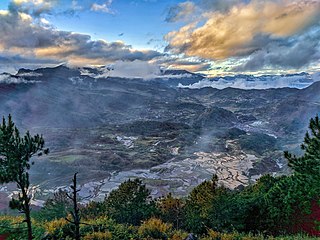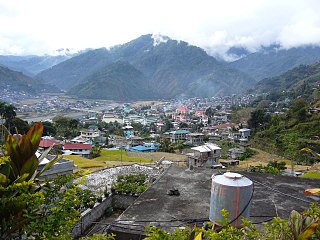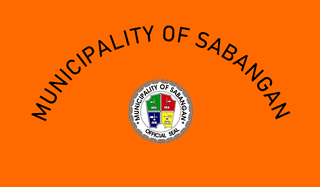Related Research Articles

Mountain Province is a landlocked province of the Philippines in the Cordillera Administrative Region in Luzon. Its capital is Bontoc. Mountain Province was formerly referred to as Mountain in some foreign references. The name is usually shortened by locals to Mt. Province.

The Cordillera Administrative Region, also known as the Cordillera Region and Cordillera, is an administrative region in the Philippines, situated within the island of Luzon. It is the only landlocked region in the insular country, bordered by the Ilocos Region to the west and southwest, and by the Cagayan Valley Region to the north, east, and southeast. It is the least populous region in the Philippines, with a population less than that of the city of Manila.

The indigenous peoples of the Cordillera Mountain Range of northern Luzon, Philippines are often referred to using the exonym Igorot people, or more recently, as the Cordilleran peoples. There are nine main ethnolinguistic groups whose domains are in the Cordillera Mountain Range, altogether numbering about 1.5 million people in the early 21st century.

Bauko, officially the Municipality of Bauko is a 4th class municipality in the province of Mountain Province, Philippines. According to the 2020 census, it has a population of 32,021 people.

The Philippine Daily Inquirer (PDI), or simply the Inquirer, is an English-language newspaper in the Philippines. Founded in 1985, it is often regarded as the Philippines' newspaper of record. The newspaper is the most awarded broadsheet in the Philippines and the multimedia group, called The Inquirer Group, reaches 54 million people across several platforms.

Bontoc, officially the Municipality of Bontoc, is a 2nd class municipality and capital of the province of Mountain Province, Philippines. According to the 2020 census, it has a population of 24,104 people.

Sabangan, officially the Municipality of Sabangan is a 5th class municipality in the province of Mountain Province, Philippines. According to the 2020 census, it has a population of 9,621 people.

Sadanga, officially the Municipality of Sadanga is a 5th class municipality in the province of Mountain Province, Philippines. According to the 2020 census, it has a population of 8,427 people. Sadanga boundaries both provinces are Abra to the northwest & west and Kalinga to the north & northeast.

Sagada, officially the Municipality of Sagada is a 5th class municipality in the province of Mountain Province, Philippines. According to the 2020 census, it has a population of 11,510 people.

The Kalinga people are an indigenous ethnic group whose ancestral domain is in the Cordillera Mountain Range of the northern Philippines. They are mainly found in Kalinga province which has an area of 3,282.58 sq. km. Some of them, however, already migrated to Mountain Province, Apayao, Cagayan, and Abra. The Kalinga numbered 163,167 as of 2010.

Eugenia "Eggie" Apostol is a Filipino publisher who played pivotal roles in the peaceful overthrow of two Philippine presidents: Ferdinand Marcos in 1986 and Joseph Estrada in 2001. She was awarded the 2006 Ramon Magsaysay Award for Journalism, Literature & Creative Communication Arts.

Letty Jimenez-Magsanoc was a Filipino journalist and editor, notable for her role in overthrowing the dictatorship of Ferdinand Marcos. She was an icon of democracy. Magsanoc was editor of the crusading weekly opposition tabloid Mr & Ms Special Edition. She was editor in chief of the Philippine Daily Inquirer.
The Chico River Dam Project was a proposed hydroelectric power generation project involving the Chico River on the island of Luzon in the Philippines that locals, notably the Kalinga people, resisted because of its threat to their residences, livelihood, and culture. The project was shelved in the 1980s after public outrage in the wake of the murder of opposition leader Macli-ing Dulag. It is now considered a landmark case study concerning ancestral domain issues in the Philippines.

Macli-ing Dulag was a pangat (leader) of the Butbut tribe of Kalinga province in the Philippines. He is best as one of the leaders of the opposition to the Chico River Dam Project, which led to his assassination by armed forces under the command of then-dictator Ferdinand Marcos.

The Bantayog ng mga Bayani, sometimes simply referred to as the Bantayog, is a monument, museum, and historical research center in Quezon City, Philippines, which honors the martyrs and heroes of the struggle against the dictatorship of former President Ferdinand Marcos.

Batas Militar is a 1997 Filipino television documentary film about martial law under Ferdinand Marcos, and the ouster movement against him, the People Power Revolution. The film was directed by Jon Red and Jeannette Ifurung, with the former focusing on dramatizations.
Antonio Ma. "Tony" Onrubia Nieva was a Philippine journalist, union organizer, and activist. He worked to defend press freedom and the rights of workers, and campaigned to end dictatorship in the Philippines. He led the National Press Club as president and founded the National Union of Journalists of the Philippines. He was secretary general of the International Organization of Journalists based in Prague, Czech Republic, from 1995 up to the time of his death in 1997. His name is on the Bantayog ng mga Bayani Wall of Remembrance, for his contributions to the fight against injustices of the dictatorship under President Ferdinand E. Marcos.
Religious sector opposition against the dictatorship of President Ferdinand Marcos included leaders and workers belonging to different beliefs and denominations.
Indigenous people’s resistance against the Marcos dictatorship varied from case to case among the various indigenous peoples of the Philippines. The most documented cases are the various resistance movements towards the Marcos administration’s appropriation of indigenous lands, particularly in the case of the Chico River Dam Project and the Manila Water Supply III project on the Kaliwa River watershed, and the birth of the various separatist groups and their coalescing into the Moro conflict in the wake of news about the Jabidah Massacre.
Journalism during the Marcos dictatorship in the Philippines—a fourteen year period between the declaration of Martial Law in 1972 until the People Power revolution in February 1986—was heavily restricted by Philippine dictator Ferdinand Marcos in order to suppress political opposition and prevent criticism of his administration.
References
- 1 2 3 Forbes, Amy (2015). "Courageous women in media: Marcos and censorship in the Philippines" (PDF). Pacific Journalism Review. 21 (1): 195–210. doi:10.24135/pjr.v21i1.157. Archived (PDF) from the original on September 1, 2021. Retrieved September 1, 2021. https://researchonline.jcu.edu.au/38499/3/38499%20Forbes%202015%20accepted%20version.pdf Archived September 1, 2021, at the Wayback Machine
- ↑ "A portrait of the Filipino as courageous journalist". April 8, 2019. Archived from the original on September 1, 2021. Retrieved September 1, 2021.
- ↑ "[Off the shelf] Human Face, a Journalist's encounter and awakening by Ma. Ceres P. Doyo". Human Rights Online Philippines. March 21, 2013. Archived from the original on September 1, 2021. Retrieved September 1, 2021.
- ↑ "Doyo, Abrera win National Book Awards". November 16, 2016. Archived from the original on September 1, 2021. Retrieved September 1, 2021.
- ↑ Sicam, Paulynn. "Women writers of martial law". The Philippine Star . Archived from the original on September 1, 2021. Retrieved September 1, 2021.
- 1 2 3 LAPEÑA, CARMELA G. "Through Marcos years and libel suits, women write on". GMA News and Public Affairs. Archived from the original on January 23, 2023. Retrieved September 1, 2021.
- ↑ Aureus, Leonor J., ed. (1985). The Philippine Press Under Siege II.
- ↑ "Ma. Ceres P. Doyo". Global Sisters Report. Archived from the original on September 1, 2021. Retrieved September 1, 2021.
- ↑ "PDI'S Doyo, Abrera win National Book Awards". Inquirer Lifestyle. November 16, 2016. Archived from the original on September 1, 2021. Retrieved September 1, 2021.
- ↑ "Philippine Center for Investigative Journalism". pcij.org. Archived from the original on October 10, 2021. Retrieved September 1, 2021.